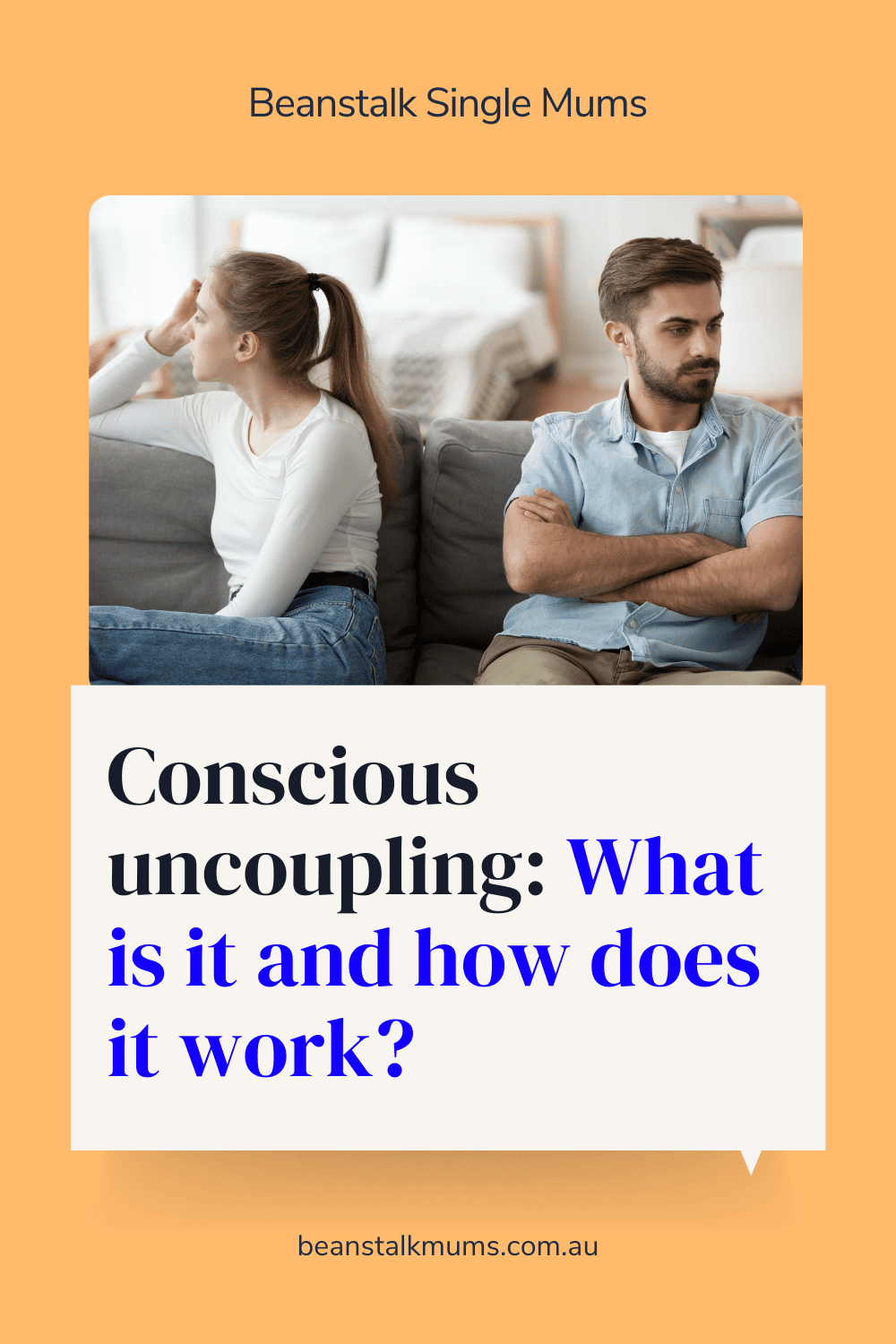
With divorce and family separation prevalent in society, there is definitely room for another approach, especially if it makes life easier for all involved. So let’s give a warm welcome to “conscious uncoupling”.
It is a term that evokes mixed feeling amongst us. We liken it to how we are the best parents ever … until we have kids. For anyone who has been through a messy (even a reasonably tidy) divorce, you might find the term conscious uncoupling a little irritating, even condescending.
But we reckon anything that might calm the farm of a separation is worth exploring.
In this article we talk about:
- What is conscious uncoupling?
- Who invented it?
- What’s it got to do with Gwyneth Paltrow?
- The benefits of conscious uncoupling, for parents and children
- The 5-step process to make it work

Further reading: Stop! Just because you’re separating, doesn’t mean you need a lawyer.
What is conscious uncoupling?
Conscious uncoupling is the process of ending a marriage or relationship in a positive way, where two people work together to remain friends and ensure the happiness of their future lives. In other words, conscious uncoupling is an un-dramatic, friendly and positive way to end a relationship, whether it’s a marriage or something short term.
Who invented it?
Katherine Woodward Thomas, an American marriage therapist, relationship coach and author, introduced the term conscious uncoupling in her 2015 book Conscious Uncoupling: The Five Steps to Living Happily Even After.
According to Katherine Woodward Thomas, conscious uncoupling is a positive way of breaking up. Instead of “ending” a relationship, the couple “completes” the relationship, learns their lessons and moves on as better people who succeed in future relationships.
Katherine invented the process during her own divorce. Both she and her husband experienced the traumatic divorce of their own parents and wanted to protect their daughter, so they worked together to ensure she had a happy childhood in spite of the breakup. She says:
“That intention kept calling us to rise to be the bigger person, to take the high road at every turn. He started a culture between us of generosity and cooperation…but I think when we divorce we forget that if we have children, we’re still going to be a family. You have to build your new family.”
What’s it got to do with Gwyneth Paltrow?
The buzzword hit the mainstream when Gwyneth Paltrow separated from Chris Martin in 2014. The couple published a newsletter on Goop, Paltrow’s website, called “conscious uncoupling” to announce their divorce, and the rest, as they say, is history.
The piece attracted public attention as most announcements of celebrity splits do, but not in a good way. In fact, Paltrow said she could not have anticipated the mockery and derision that came her way.
She said she had never heard of the phrase at that time, but learned it from their therapists Habib Sadeghi and his wife Sherry Sami.
According to Sadeghi:
“Conscious uncoupling is the ability to understand that every irritation and argument [within a marriage] was a signal to look inside ourselves and identify a negative internal object that needed healing”.
Conscious uncoupling has since become an established part of breakup culture and is possibly the best way to move on after the trauma of separation.
The benefits of conscious uncoupling, for parent and children
Why it’s great for separating parents
The act of minimising the damage of a separation through conscious uncoupling has many benefits for parents and children.
- Grow from the experience. One of the goals of conscious uncoupling is to end a relationship without blame, shame, or guilt. In short, turning a traumatic experience into something that is less painful, hostile and stunting for both parties, so they can move on to their new lives whole and intact.
- Protect your children. Most parents want the best for their children, including a happy childhood not scarred by a long-drawn and bitter divorce. Conscious uncoupling puts the kids first and protects them from collateral damage.
- Avoid an acrimonious and expensive separation. A contentious divorce can drain a couple’s bank account and take a serious toll on the entire family. An amicable separation can help couples avoid endless courtroom battles.
How children can benefit from conscious uncoupling
- Create a stable and safe environment. With an amicable separation, your kids can continue their normal life with minimal disruption. They can continue to receive love, attention and support from both parents, as well as friends and extended family members.
- Minimise the negative impact on their mental health. A stressful and bitter separation is traumatic for even the most well-adjusted adults, let alone for your children. Conscious uncoupling removes the drama, pain and distress that would otherwise harm their mental health.
- Teach your kids to effectively deal with conflict and difficult emotions. Children do as you do even if they don’t do as you say. Give your kids an arsenal of tools to deal with conflict and difficult emotions through an amicable and respectful method of separation.
The 5-step process to make it work
1. Find emotional freedom
Emotions can run amok during and after a breakup, but there is a way to control them so the negativity does not inform your decision making. At this stage, you can use difficult feelings to create positive changes in your life. For example, you can use a negative emotion like anger at your ex to drive an intention like “I will never date narcissists again.”
2. Reclaim your power and your life
This step is about taking responsibility and seeing the part you played in the dissolution of the relationship, without blame or shame, and understanding the reasons behind giving away power, like failing to set boundaries. It’s like looking inwards into the relationship dynamics from a third-person point of view, “seeing yourself as the co-creator of what happened” and making amends to yourself.
As per Gwyneth Paltrow:
“Learning to let go of spite is crucial, too. Spite makes us believe we are “right”. It keeps us blind to our own faults. The point of a break-up, if you have to go through it, is to grow. To use the opportunity to really look at yourself and heal broken patterns so you don’t find yourself in the same situation again. “
3. Break the pattern, heal your heart
Understanding your own history, emotional dysfunction and view of an “ideal relationship” can help you correct self-destructive thoughts and behaviour moving forward. If your own parents divorced, for instance, you may end up deciding that you are born to be alone because people you love will always leave. Correct the narrative with mantras like “I am not alone,” and “I can learn how to have healthier relationships.”
Further reading: 8 Golden rules to lower conflict when talking to your ex.
4. Become a love alchemist
Step 4 is all about transformation. It’s about hitting the reset button, turning all the resentment and bitterness into lessons and wisdom that you can apply to your new life. It involves forgiving yourself and your ex, making peace with the past, and not letting difficult emotions trigger you like they once did.
According to Gwyneth:
“But I came to understand that forgiveness involves taking responsibility for your half of the relationship. You cannot begin to forgive until you have felt what it is like to be in your partner’s shoes, coping with the hardest parts of you, your trauma, your dysfunction.”
5. Create your “happy even after” life
The last step is all about happily ever afters despite all the pain and disillusionment. The ex-couple creates a situation where everyone wins (this can be fair division of assets and living arrangements for your kids) and defines their role in the new relationship, for example, whether you will stay friends and co-parent together.
Even if your ex is uncooperative (mental illness, abusive, prison etc), it’s about identifying what’s possible given the situation and being as kind as possible.
As Katherine Woodward Thomas says:
“Conscious uncoupling is a thing we aspire to. I haven’t met one person who has done it perfectly, myself included. It’s a roadmap and gives you the tools to navigate your way there.”














